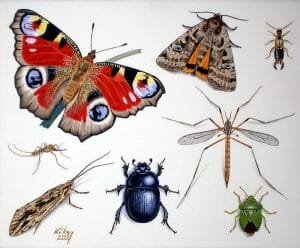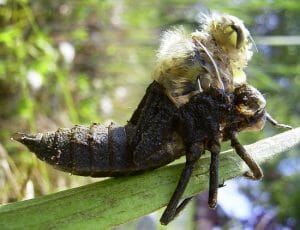Exoskeleton Definition
An exoskeleton is the rigid covering found on the exterior of many animals, particularly invertebrates such as arthropods and mollusks.
Much like the internal endoskeleton of vertebrates, the exoskeleton is responsible for supporting the structure of an animal’s body.
The exoskeleton also provides protection against attack from predators, and accidental damage of the soft internal organs. Furthermore, due to the waterproof qualities of the skeletal tissues, an exoskeleton acts as a barrier and protects organisms from desiccation.
In arthropods, the muscles are attached directly to the interior of the exoskeleton—unlike in vertebrate endoskeletons, where the muscles are connected to the skeleton via tendons and ligaments. This direct connection means that there is a larger surface area for the muscle to attach to, allowing for powerful movement and strength. Additionally, jointed limbs, which connect the hard exterior plates, permit a wide range of available movements.
Although the bones found in endoskeletons are quite lightweight, the materials that make up the structure of exoskeletons are relatively heavy. This limits the size that an organism with an exoskeleton can grow to, which is one of the reasons why insects have small bodies.

The image shows insects from the Arthropoda phylum. Each one has a form of exoskeleton.
Types of Exoskeleton
The Arthropod Cuticle
The exoskeleton of animals within the phylum Arthropoda mainly consists of a coating called the cuticle. This is formed of both living and non-living layers. The living layer is a row of epithelial cells resting on a basement membrane. These cells secrete the non-living material of the cuticle.
On the exterior surface of the cuticle is a thin, waxy layer called the epicuticle. The epicuticle is formed of three layers; the inner layer is the cuticulin, which is made from lipoproteins. On top of this is a waxy layer, which acts to retain water within the cuticle and reject water from outside. This wax layer is highly fragile, so is protected by the outermost ‘cement layer’.

The interior procuticle is made primarily from chitin, a translucent, fibrous material consisting of modified, nitrogen-containing polysaccharides. This form of carbohydrate is similar to the cellulose found in the cell walls of plants.
The procuticle consists of two parts, the endocuticle and the exocuticle.
The interior endocuticle is a pale colored, highly flexible structure, formed of interwoven fibers of chitin and protein molecules.
Within the exocuticle, the chitin is reinforced to add hardness and strength to the exoskeleton through the process of sclerotization. This involves the crosslinking of various proteins to formsclerotin, a dark colored pigment which colors the cuticle of various insects, such as beetles, millipedes, spiders and scorpions.
Chitin is also sometimes combined with calcium carbonate in a process called biomineralization. In arthropods, biomineralization is most commonly used to harden the shells of crustaceans such as crabs, shrimp and woodlice.
The hardened components that are formed are called sclerites. These may be the plates that form the protective armor of the exoskeleton, or they may take the form of mechanical body parts such as claws, legs, joints, radula and wings.
The Shell
Animals of the Mollusca phylum typically have an exoskeleton in the form of a shell; this includes gastropod snails and whelks, bivalve mussels, oysters and clams, chitons, and nautilus cephalopods.
The shell consists mainly of calcium carbonate and proteins called conchiolins, which are secreted by the epithelial cells on a tissue of the mollusk called the mantle.
The layers of the shell are generally one of two types: the chalky outer layer and the pearly inner layer.
The outermost layer—the periostracum—consists of organic conchiolin proteins. The middle layer is the ostracum; this is formed by tall, vertically stacked and tightly packed prisms of calcium carbonate. These two layers are secreted by a band of cells at the edge of the mantle, so that the shell grows from the outer edge.
The innermost layer is the hypostracum or nacreous layer. This consists of thin, flat platelets of aragonite, a form of calcium carbonate. The hexagonal disks are horizontally stacked in a formation similar to that of a brick wall, giving the material great strength. This iridescent layer of nacre—commonly called ‘mother of pearl’—is secreted directly from epithelial cells in the mantle. Conchiolin is present within the periostracum and the nacreous layers, helping to cement the crystalline prisms together.
Molting
Due to the physical properties of the non-living exoskeleton structure, there are restraints on the possibilities of growth. Although certain creatures, such as mollusks, are able to grow their shells by adding material to the edges, most exoskeletons must be shed by molting and then regrown; this is in contrast to the living endoskeleton of most vertebrates, which grows along with the rest of the body.
In arthropods such as insects and crustaceans, the process of replacing the exoskeleton is called ecdysis. This happens in three main stages.
Firstly, as the arthropod grows, a steroidal hormone called ecdysone is released into the body; this signals the beginning of the molting process. The organism then becomes inactive while the cuticle is separated from the underlying epidermal cells in a process called apolysis.
A digestive fluid is then secreted into the space between the old cuticle and the epidermis, known as the exuvial space. This fluid remains inactive until the epidermis has secreted a new epicuticle. It is important to note that the new cuticle is larger than the old one, although because it is initially soft tissue, it is able to fold and wrinkle underneath the old cuticle until it is ready to be used.
The molting fluid begins to digest the soft inner layers of the old cuticle from underneath; the proteins and mineral salts are often reabsorbed into the body.
The final stage is true ecdysis, in which the organism expands its body by taking in water or air, or by greatly increasing its blood pressure. This cracks the surface of the old cuticle and the animal is able to slide out of the old exoskeleton case. By inflating, the newly free animal is able to stretch out the new cuticle and begin the process of sclerotization or biomineralization to harden the surface.
Although there are advantages to molting, such as regrowth of damaged limbs, and the ability to perform metamorphosis, it is an extremely dangerous process. Before the new exoskeleton has hardened (this can sometimes take several days), the soft interior is exposed and is extremely vulnerable to predators. Around 85% of arthropod deaths occur during the molting period! Because of the dangers, molting animals usually seek shelter during the process in an attempt to lessen their vulnerability.

The image shows a dragonfly, Libellula quadrimaculata, emerging from its the old cuticle of its exoskeleton after ecdysis.
Related Biology Terms
- Endoskeleton – The internal bone structure that supports the body of many vertebrate organisms.
- Hydrostatic Skeleton – The soft skeletal structure found in some invertebrates, consisting of a fluid filled cavity called a coelom.
- Invertebrate – An organism within the animal kingdom that does not posses a backbone.
Quiz
1. In which way are exoskeletons similar to endoskeletons?
A. They are both made from non-living materials
B. They are both responsible for structural support of the body
C. They are made of the same tissue materials
D. They are attached to muscles in the same way
2. What substance is used to harden the exoskeleton through biomineralization?
A. Sclerite
B. Ecdysone
C. Calcium Carbonate
D. Chitin
3. Which of the following is not a feature of the arthropod cuticle?
A. The cement layer
B. The cuticulin
C. Chitin
D. The nacreous layer
